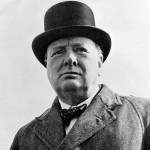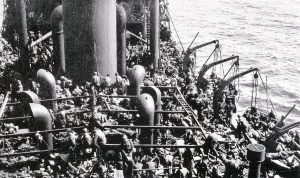operation aerial

 In a war, sometimes the best thing that can be done is to retreat, but that is not always easy to do. When the enemy is closing in and there seems no way of escape. Sometimes, a way of escape seems to come together in such a way that it almost seems miraculous…or maybe that is the only real explanation…a miracle. Such seemed to be the case with Britain both in Dunkirk, France, called Operation Dynamo, and again from Cherbourg, Saint Malo, Brest, and Nantes, dubbed Operation Aerial. The evacuation from Dunkirk, was most likely the largest of its kind, or at least up to that date. I suppose there might have been others since then, but I am not aware of any. During the evacuation of Dunkirk, the British managed to evacuate 338,226 soldiers…and almost unheard of amount of men were saved, by a coordinated effort using 860 boats. During Operation Ariel, another 191,870 troops were rescued, bringing the total of military and civilian personnel returned to Britain during the Battle of France to 558,032, including 368,491 British troops.
In a war, sometimes the best thing that can be done is to retreat, but that is not always easy to do. When the enemy is closing in and there seems no way of escape. Sometimes, a way of escape seems to come together in such a way that it almost seems miraculous…or maybe that is the only real explanation…a miracle. Such seemed to be the case with Britain both in Dunkirk, France, called Operation Dynamo, and again from Cherbourg, Saint Malo, Brest, and Nantes, dubbed Operation Aerial. The evacuation from Dunkirk, was most likely the largest of its kind, or at least up to that date. I suppose there might have been others since then, but I am not aware of any. During the evacuation of Dunkirk, the British managed to evacuate 338,226 soldiers…and almost unheard of amount of men were saved, by a coordinated effort using 860 boats. During Operation Ariel, another 191,870 troops were rescued, bringing the total of military and civilian personnel returned to Britain during the Battle of France to 558,032, including 368,491 British troops.
Operation Aerial began on June 15, 1940 and ended on June 25, 1940. Following the military collapse in the Battle of France against Nazi Germany, it became evident that Allied soldiers and civilians were in grave danger. With two-thirds of France now occupied by German troops, those British and Allied troops that had not participated in Operation Dynamo, the evacuation of Dunkirk, were shipped home, but there remained a concern for the areas from Cherbourg, St. Malo, Brest, and Nantes. While these men were not under the immediate threat of assault, as at Dunkirk, they were by no means safe, so Brits, Poles, and Canadian troops were rescued from occupied territory by boats sent from Britain. Meanwhile, British Prime Minister Winston Churchill offered words of encouragement in a broadcast to the nation, “Whatever has happened in France…we shall defend our island home, and with the British Empire we shall fight on unconquerable until the curse of Hitler is lifted.” This was his way of promising that Britain would never fall under Nazi rule.
Operation Aerial was split into two sectors. Admiral James, based at Portsmouth, was to control the evacuation from Cherbourg and St Malo, while Admiral Dunbar-Nasmith, the commander-in-chief of the Western Approaches, based at Plymouth, would control the evacuation from Brest, St. Nazaire and La Pallice. Eventually this western evacuation would extend to include the ports on the Gironde estuary, Bayonne and St Jean-de-Luz. Once the people were on board, I’m sure they thought they were finally safe, but that was not necessarily the case. The Germans attacked the rescue boats. Among those rescued from the shores of France, were 5,000 soldiers and French civilians on board the ocean liner Lancastria, which had picked them up at St. Nazaire. Germans bombers sunk the liner on June 17, 1940, and 3,000 passengers drowned. Churchill ordered that news of the Lancastria not be broadcast in Britain, fearing the effect it would have on public morale, since everyone was already worried about a possible German invasion now that only a channel separated them. The British public would eventually find out, but not for another six weeks, when the news broke in the United States. They would also receive the good news that Hitler had no immediate plans for an invasion of the British isle, “being well aware of the difficulties involved in such an operation,” reported the German High Command.


In the end, the evacuations dubbed Operation Dynamo and Operation Aerial, were successful, in that most of those who were evacuated made it home. I’m sure that the retreats did not feel like a success or a victory to the soldiers fighting in the Battle of France, but I am also sure that they were thankful to be among those who made it home. They would live to fight another day in the horrendous war that was World War II.

